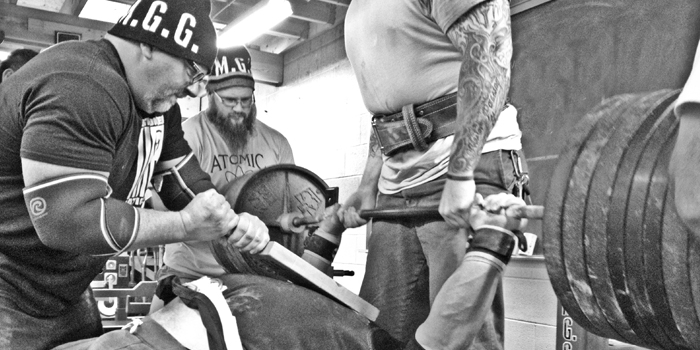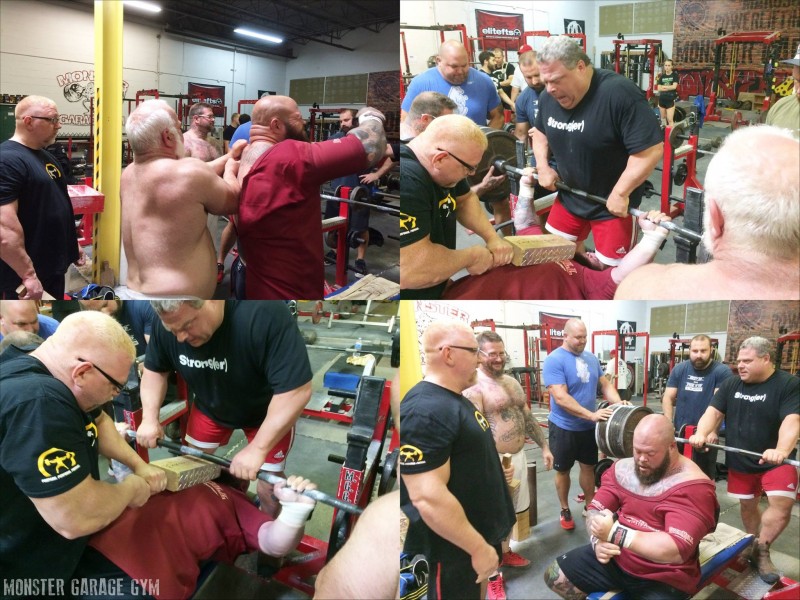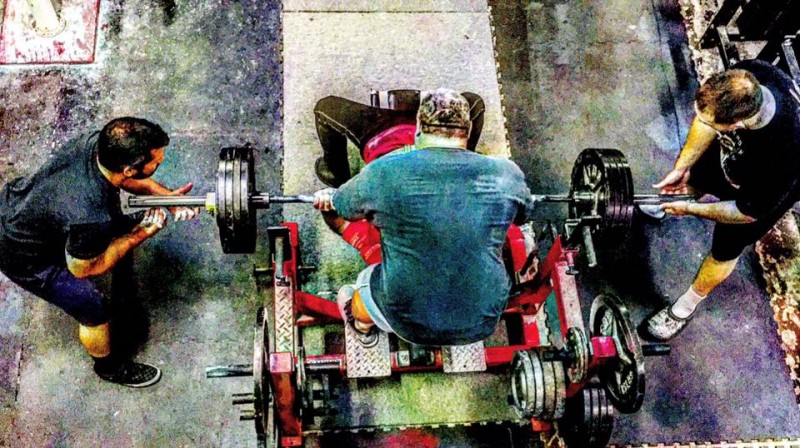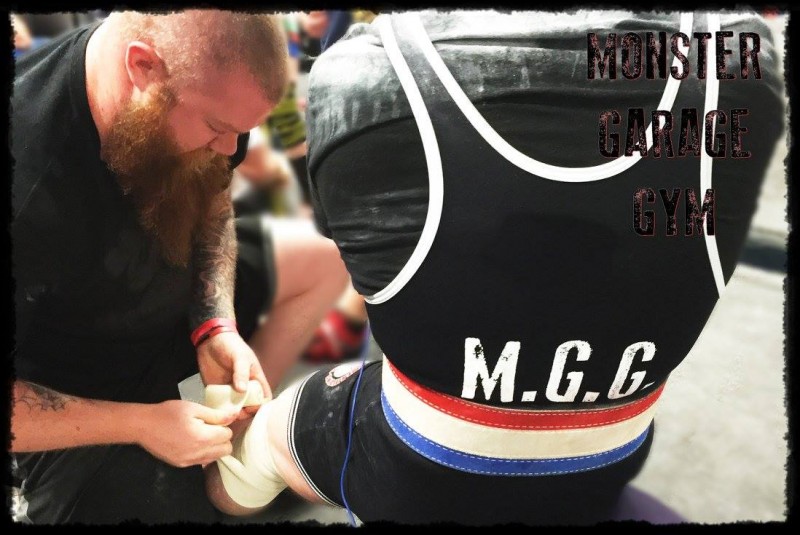
There is an old adage that goes something like this: “Don’t bring up a problem unless you have a solution.” That is the intent of this article — to examine a problem that you have undoubtedly seen, encountered, or perhaps even experienced personally, and then offer a solution to consider. With that all said, let’s begin.
I really have to concentrate to think of a more pervasive single entity that has done more to derail a training session than the smartphone. In past coaching logs and articles we have touched on this topic, but more than discussing, we have provided the science base behind the disruption (meaning the “why” behind the training disruption, well beyond the obvious annoyance factor). I have looked at the research behind it, because with over two decades of competitive powerlifting under my belt and over 40 years with some type of weight in my hands, I have never seen one singular thing that has, through its permeation, caused so much disruption to a workout. But of more concern, it is more often than not an unrecognized disruption.
RELATED: Putting Pen to Paper — When Old School Is Better Than New Technology
There have always been those folks in the gym that come up to talk with you after a set, and after catching your breath and exchanging some pleasantries, you politely end the brief conversation and head back over for the next set. It is an unstated rule that you don’t interrupt the serious lifter with idle chitchat, and for the most part we all live by that code. We are of course not talking about the corporate gym atmosphere, where the venue is often a 50/50 mix of water-cooler chat and exercise. We are speaking specifically of the training environment where you have precious limited time to hit your numbers, as each session is one day closer to the meet.
So in our powerlifting subculture, there is etiquette. A code of conduct. An unspoken rule, so to speak, that you just simply don’t interrupt a serious training session. This rule of non-interruption is the absolute antithesis of what the smartphone can do in the training environment. The irony is that the disruption of the powerlifters training is actually caused by the athletes themselves. Said another way, a serious lifter would never tolerate a disruption of their training from another individual, yet with their own smartphone, they personally create and actually invite that very disruption into their own training session.

The vast majority of serious powerlifters tuck away the cellphone deep into their gym bag during training, as they can see the disruption. None the less, some who have seen this training disruption in other lifters (which is detailed below) still sometimes allow for the smartphone to invade their own training as they dig into the gym bag to look at the phone in between sets.
No lifter would intentionally want to discombobulate their training. The only possible explanation behind this self-sabotage is that the user doesn’t understand what is physically happening to them each time they gaze into the screen of their phone during training. They don’t realize that unlike a conversation, where you still maintain your sense of time, the fight or flight response is significantly disrupted by the smartphone and the lifter becomes lost in time, and thus one scroll turns into 100 scrolls, and one minute holding the device turns into eight, nine, and ten or more minutes.
The time between sets—the time it takes to walk over and take a sip of your water, coffee, or BCAA’s and write in your training log—is actually connected mental time where your mind processes the last set and is still engaged and growing ready for the next set. In other words, each set crescendos into the next set so our workout is a buildup of strength and power, set after set after set, and our mind (the key ingredient to training) is constantly readying us for the next bigger weight. What is troubling is the significant impact the smartphone has on the lifter that a brief in-person conversation does not have. Looking at the cellphone substantially disrupts this essential mental process of connectivity between sets. It turns a constant flow of working sets building up to the big max effort sets into fragmented individual sets that, due to their disconnected and disjointed nature, compromise the big sets.
In fact, without the mental connectivity of the building sets, the big sets are often missed. This is because the weights on the program are designed to get progressively heavier, but as now the mind is not connecting the sets, absent is the connectivity to handle the greater poundage on the bar. The problem is simply that when the mind is not connected, the body is not connected. As the pattern of the training crescendo is disrupted, the buildup of our natural hormones that help in the gym are disrupted and the time between sets is increased exponentially beyond the time needed to simply catch our breath. The great Lee Haney used to say, “The muscle without the mind is nothing. You must at all times in the gym keep the mind-muscle connection.” This lack of connectivity is the very reason so many automobile accidents occur while texting. The driver simply loses the fight or flight mechanism and the sense of time is lost, so as the driver gets lost in the text, they plow head-on into a car, truck, or telephone pole.

We see this play out so much with younger lifters in the gym, as they have probably never lifted without a smartphone. I use the word "lifted," as the science suggests you can’t “train” using the smartphone, for all of the aforementioned reasons. What we also see unfortunately is the more seasoned lifter fall prey to this as well. I have seen lifters who were once ravenous during their training stop in their tracks as they go into that motionless trance we have all seen. Standing upright, with their head looking down to the phone in their hand, they scroll and scroll and scroll, all the while their mind-muscle connection and continuity between sets fades away until there is a disconnect and the momentum from the prior set is lost.
The non-cellphone users see this; in fact, you can’t miss it. They see the extended time between sets and they see the absolute disconnect. The newbie to the veteran cellphone-lifters are unknowingly, unwittingly stealing their own time, eroding their own strength, and compromising their own training and their own competition goals. If they could see themselves in that motionless, zombie-like, frozen head-down stare at the screen while others complete three sets to their one disconnected set, they would be aghast, and they would never bring that workout-killer into the gym again.
Over the decades I have had the pleasure of meeting some amazing lifters and amazing mentors, coaches, and teachers of our sport. Over these years I have never had the privilege of meeting the legendary powerlifting coach, Mr. Louie Simmons, but I am going to take a wild guess and say that I highly doubt his lifters at WSBB whip out a cell phone and check their social status or send a text or message between sets during one of his training sessions. My guess is they are most likely trying just to catch their breath, are completely engaged in helping the other lifters they are training with, and are beginning to focus on their next set.
Studies suggest that even those who use the cell phone for logging their progress through an app fall prey to this blue light issue. The apps are great for tracking lifts, but the blue light is still there. Science says with the blue light present so then also is the mental disruption you need to avoid if you wish to maintain the aforementioned lifting crescendo.
So we know that writing in a training journal fosters connectivity between sets. And we know that the cell phone causes major neural disruption to the training. But we also want easy access to our training on the computer, as that is our data that we study. That is the data that we can plot into a sigmoid curve. That is the data that lets us know if we are on the right trajectory with our training.
As I said at the very start, there is an old adage that goes something like this: “Don’t bring up problems unless you have solutions.” That is the intent of this article. So the problem is, science informs you that using the smartphone during training is counterproductive, but you are a serious lifter who wants to be able to have your training on the computer in nice, neat folders so you can track your progress or lack thereof. The solution to that problem that I am going to offer and layout below is the Rocketbook Wave. If, on the other hand, the problem is that the lifter is simply someone who can’t stop using their phone while training, and again, the data has been laid out for them that using the smartphone while training is counterproductive, I submit that they are not truly 100% in. And of this, there is no rebuke.

Unless they have an issue with a loved one in the hospital, someone is expecting, or there is some emergency that they must monitor with the device during training, there is simply no reason not to have the phone stuffed into the gym bag, bottom line, end of story (double negative intended). The science is irrefutable, we can intuitively feel it when distracted by the device, and the Princeton study is the nail in the blue screen coffin. So, for those who use the device for logging lifts, detailed below is a solution to consider. The lifters who fall into the other category and who habitually check the thing between reps will continue to compromise their training, which will erode their full meet capability.
Business Insider states that, according to the research firm Dscout, the average smartphone user touches their cell phone 2,617 times per day, which includes taps, swipes, and clicks. What we also know is that those who are habitually checking their phones actually build up cortisol when they don’t check their phones. Lots of clicking and building up of one's cortisol are two counterproductive ingredients for a great training session. This is in addition to the overwhelming data regarding the blue screen and attention derailment, for lack of a better term.
All that said, let’s talk Rocketbook Wave as a solution for the initial training log data problem. Recently for my life outside of the gym, I have been using a thing called Rocketbook Wave for work and business. So, what is a Rocketbook Wave and how can it help you with your training?
The Rocketbook Wave is literally a notebook, just like your training log. The lifter opens the Rocketbook Wave or notebook, and as their training session unfurls, the lifter simply logs the relevant sets, reps, and any other notes onto the page. Pretty simple, and lifters have done this since day one. As mentioned in the article linked above and the parallels drawn when looking at the research of the Princeton study, logging of the training day gives the lifter mini downtimes between sets, and the tactile impact of the pen to paper allows the lifter to process the set they just completed while keeping them totally engaged in the complete session. As there is no blue light with pen and paper, the fight or flight response and time acuity stays intact. It also serves the obvious purpose of documenting the session, as each session during a training cycle produces a micro picture of the larger program. Notes from the prior squat day, for example, are to be reflected on before the next subsequent squat day.
Where the Rocketbook Wave differs from the old school training log is that after you finish the training day, you can store that information on the cloud so that your training data is organized the way you like it. What? How does that work?
I was thinking about how I would describe this process of seamlessly moving the written data to your Google drive in detail, but rather than reinvent the wheel, here is a two-minute video on how it works. Watch this video and we will meet down in the next paragraph. See you in two minutes.
Now that you have seen the video on how the Rocketbook Wave works, it is pretty obvious how this pen-to-paper technology serves two masters. First, for the lifters who want to roll old school with pad and paper training logs, they can use the Rocketbook Wave to take all their notes while avoiding the pitfalls of the cell phone. Having said that, the second point is that they can open the app, snap the photo of their training page(s) at the end of their training day, hit send per the app, and instantaneously have their training logs in the cloud (or whatever storage vernacular you want to use). For me personally, I have Google folders and documents set up for the different days, but also one for days when I hit a PR on a given movement, as this makes it really easy to find and also eliminates flipping through pages and pages of log entries to find the last, say, rackable cambered bar max for five reps.
If you like to use an app to track your sets and reps but are deterred by information about blue light (the aforementioned article link goes into a study at Princeton University that is a deeper dive into this topic, so you will want to check that out) the Rocketbook Wave is a great option. The book sells for approximately $25, which is a great deal for 80 pages. You can reuse the book over and over again with the microwave feature, and this price includes the pen, which of course you can purchase more of.
The bottom line is this: You are now armed with some crucial information that can impact your lifting. This is information based on fact that we feel can benefit your training and meet prep, thus the mantra of elitefts: Live, Learn, Pass On. That said, what you do or what you do not do with that information is up to you. Either choice you make will impact your training.
Wishing you the best in your training and competitions. Ever Onward.











4 Comments